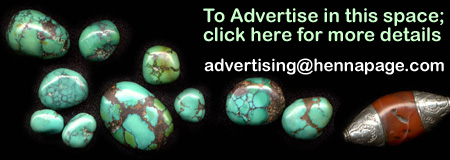|
The Henna Page Journal |

|
The following are general guidelines for preparation of a conventional manuscript . The author must carefully proofread the paper to eliminate grammatical errors and misspellings. The text should be directed at a general readership, not specialists. Avoid acronyms and jargon, even if they seem of common usage. If unavoidable, define them in the text. Notation should be unambiguous, concise, and consistent with standard usage. Introduce new terminology or notation only when clearly needed. Ideally, illustrations are planned for reduction to final journal size on the basis of their content and detail. The size of lettering should be chosen with this in mind. Typical final sizing is 350 pixels in the longest dimension. Ultimately it is the responsibility of the author to provide a paper of the proper length.
In a case of excessive length, the paper must be shortened or re-written in parts. Upon acceptance of a paper for publication, length is again considered by the team; the author may be requested to supply a shortened version before production can proceed. The composition of the paper into journal pages is the final criterion. If the length is still excessive publication is delayed until satisfactory cuts are obtained or agreement is reached with regard to publishing the material in parts. The title should be concise, but informative enough to instruct the nonexpert reader and to facilitate information retrieval. Do not introduce new terminology in titles. The names of authors may be listed in any order in the byline beneath the title. The author who submits the paper should ensure that all persons listed as authors approve the inclusion of their names, and check that the form of each name is the one normally used by that author. Authors should always use the same form of their name within the publication to facilitate indexing. A final acknowledgments paragraph may be used to recognize named individuals who contributed to the specific research of the paper, to cite the funding agencies that provided financial support for the work, and to note the affiliation of institutions. Footnotes, both references and remarks, must be numbered consecutively in order of citation, and be given in a double-spaced list at the end of the main text. It is important to confirm the accuracy of bibliographic information in references. Illustrations, should be planned with the Journal layout in mind but should not be scaled or sized by the author without prior consultation with the picture editor (editor@hennapage.com). Over-size originals or prints are preferable to journal-size originals. Authors are encouraged to submit all illustrations electronically. Illustrations submitted on paper should be of high quality and suitable for digital scanning. All illustrations must be prepared so that the details can be seen after publication. Illustrations should be numbered in the order in which they are referred to in the text. An indication, e.g., "TOP," of the intended orientation of an illustration is helpful in ambiguous cases. Each illustration must have a caption that makes the illustration intelligible without reference to the text. Any text should be placed in the caption, not on the illustration. Groups of pictures that share a (single) caption must be labeled "(a), (b)," etc. Use consistent lettering and style as in the body of the text Avoid submitting prescreened prints of photographic material or laser-printed renditions of continuous-tone data; reproduction of such figures is seldom satisfactory and there is a risk of moirè patterns appearing in the final product. Editorial decisions pertaining to the suitability or quality of visual material for publication are final.
|
||
| [Home] [How] [Why] [What] [Where] [FAQ] [Forum] | |||
 |
|||